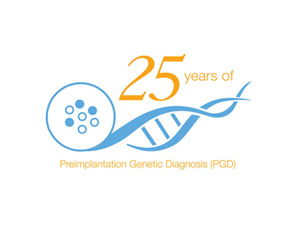
29 July 2015
In 1978, Dr. Robert G. Edwards completed the first successful in vitro fertilization (IVF) procedure, fertilizing an egg with a sperm outside of a human body. With the innovation of IVF came the possibility of eliminating debilitating genetic diseases, but it would be more than a decade before a new technology of this magnitude was possible.
In July 1990, employing a radically new process called preimplantation genetic diagnosis (PGD), Dr. Alan Handyside successfully performed the first procedure to ensure that embryos selected for implantation during an IVF cycle did not contain the inherited disease gene for cystic fibrosis (CF).
Dr. Handyside based his diagnostic technique on basic genetics and Punnett squares. Specifically, if both parents carry a recessive gene for cystic fibrosis, there is a one in four chance of their child having the disease. The child has a 50 percent possibility of being a carrier of CF if he has one mutated CF gene and one non-mutated gene. With two copies of the non-mutated gene (25 percent chance), the child will not have CF.

By using a genetic analysis technology called FISH (fluorescent in situ hybridization), Dr. Handyside was able to take the known genetic sequence for the mutated CF gene and “light up” the embryo(s) that contained this mutated sequence. Then, he was able to select only the embryos that did not have the mutated gene to implant back into the woman’s uterus during IVF.
While this technology was used for many years, due to the variability in genetic code from person to person, each couple’s PGD test had to be tailor-made, which could take months. Costs were high and there was often a long wait before IVF treatment could begin.
A new process called karyomapping is also now used regularly at fertility clinics worldwide. This technology, offered through Illumina, allows far more comprehensive testing. Today, it is possible to identify over 4,000 single-gene disorders to prevent inherited diseases including CF, sickle cell anemia, Huntington’s disease and even the known cancer gene BRCA1.
Importantly, advances in the field of genomics have led to the utilization of improved genetics technology to assess all 23 pairs of chromosomes, where the FISH technology was able to evaluate only five chromosomes.
Expanding technology helps couples struggling with infertility
PGD can often be confused with preimplantation genetic screening (PGS), which, using new next-generation sequencing technology, can now accurately identify embryos with a normal number of chromosomes. PGD has the ability to screen for a known single gene disorder on specific chromosomes, whereas PGS looks at the entire chromosome complement to identify embryos with normal numbers of chromosomes.
Chromosomes normally come in pairs. People usually have 23 pairs of chromosomes, the last pair of which determines sex. Men normally have an XY pair of sex chromosomes, while women normally have an XX pair of sex chromosomes. Sometimes, a genetic change causes an extra or missing chromosome, referred to as aneuploidy.
Chromosome aneuploidy is a major cause of IVF failure, as most embryos with aneuploidy will not implant or will miscarry during the first trimester of pregnancy.[i],[ii] In fact, at least half of all miscarriage results from chromosome abnormalities.[iii]
Real stories of PGD and PGS
As we celebrate the momentous accomplishment of 25 years for PGD, we also celebrate the advances in infertility research including PGS.
PGD technology comes to life today with Katie and her husband David, who desired a family. David was diagnosed with amyotrophic lateral sclerosis (ALS) also known as Lou Gehrig’s and motor neuron disease. To view their story and how they eliminated ALS from their family tree moving forward, please view the video below.
Similarly, the story of Vy and Kyle demonstrates how Illumina’s PGS technology allowed them to expand their family in the face of infertility. As the happy parents of a baby girl with another sibling on the way, they recommend PGS to others experiencing fertility challenges. Here's their story:
If you would like more information about PGD or PGS, please visit the Illumina website for our full spectrum of reproductive and genetic health solutions.
-----------------------------------------------------------------------------------------------------------------------------------------
[1] Scott RT Jr, Ferry K, Su J, Tao X, Scott K, et al. (2012) Comprehensive chromosome screening is highly predictive of the reproductive potential of human embryos: a prospective, blinded, nonselection study. Fertil Steril 97(4): 870-975.
[1] Tobias E, Connor JM, Ferguson-Smith (2011) Essential medical genetics. 6th edition: 243-247. Chichester, West Sussex, UK. Wiley-Blackwell.
[1]http://www.glowm.com/section_view/heading/Genetic%20and%20Nongenetic%20Causes%20of%20Pregnancy%20Loss/item/318#r40 – accessed July 3, 2015.


